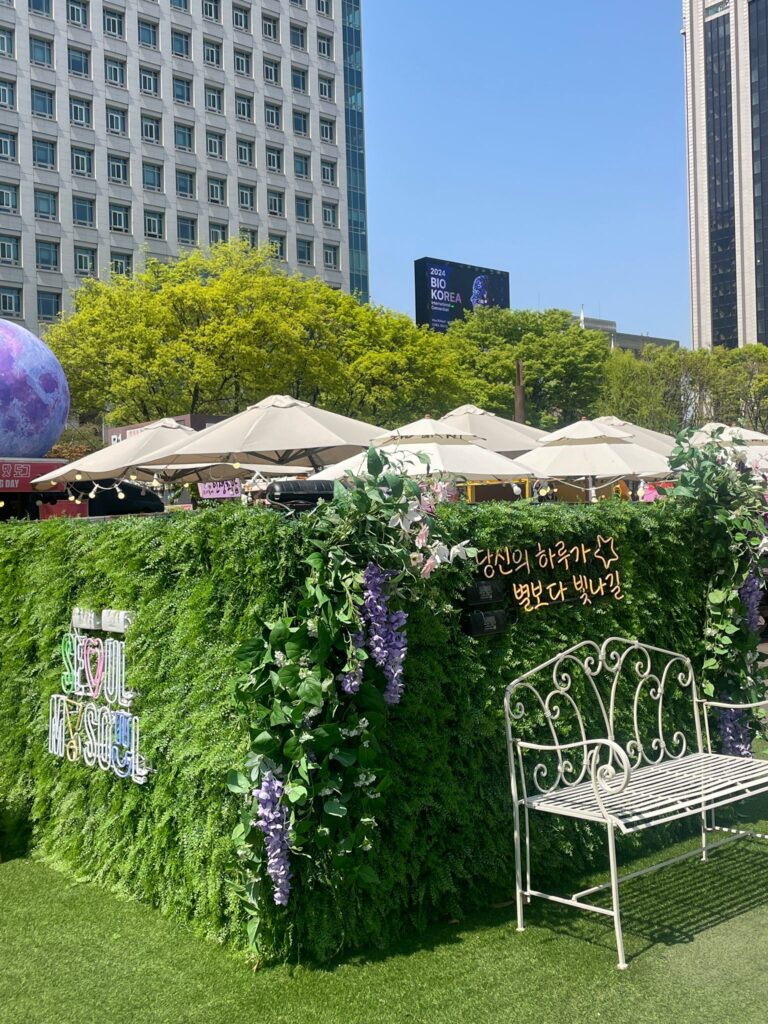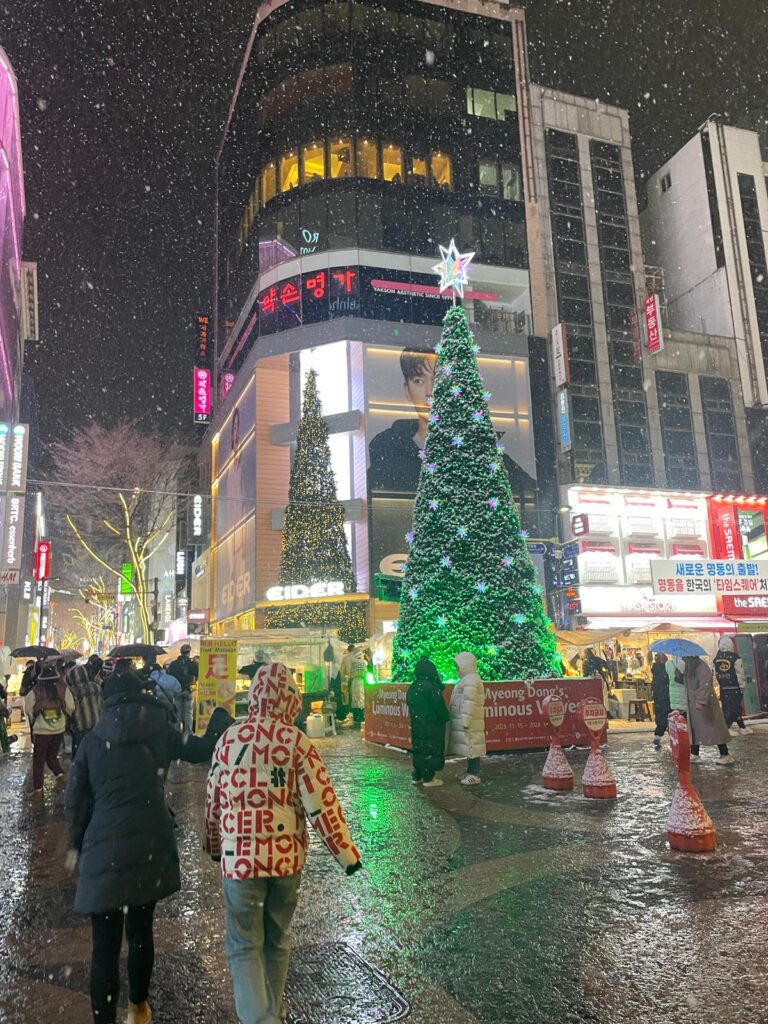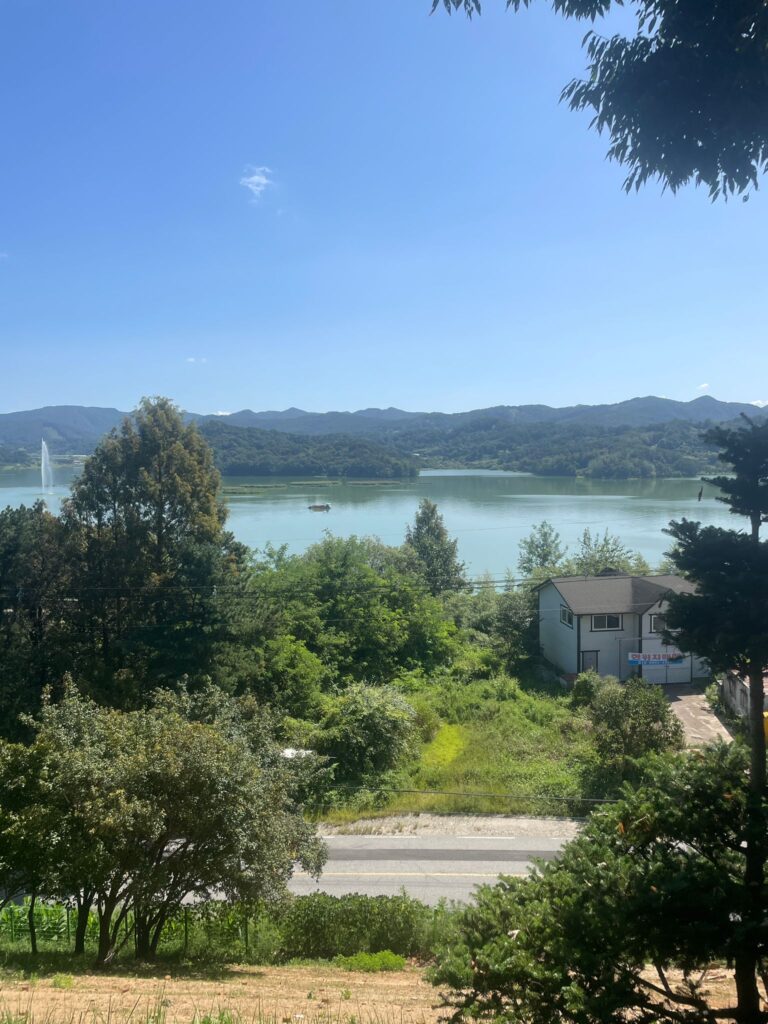When is the Best Time to Visit South Korea?
Disclaimer: Some links on this page may be affiliate links. If you purchase anything through them, I will receive a small commission at no extra cost to you! Further details in the Privacy Policy.
As an expat spending a year here as an English teacher, I can tell you the best time to visit South Korea from first hand experience.
The best month by far for visiting South Korea is April. It not only has lovely warm (but not scorching hot) temperatures. April is also cherry blossom season which attracts swathes of visitors.
Spring time (March-May) is easily the best time of year to travel to South Korea. The spring is pleasantly warm, there are many more sunny days than rainy ones, and it avoids the extremes of Korea’s punishingly sweaty summers and biting cold winters.
After spring, autumn is the next-best season with enjoyable temperatures and again, minimal rainfall. Coming from the UK I found autumn (fall for you Americans) to be a pleasant surprise here as it’s normally blustery and chilly back home. Korean autumn is more like the tail end of a British summer.
South Korea is a relatively small country, with little variation in the weather from north to south.
Here I will go through the pros and cons of visiting South Korea in each month of the year.

Winter in South Korea
December
December I would say is almost the worst month to visit South Korea. It is the start of a very bleak winter season and the winters here certainly aren’t fun.
Even wrapped up in a warm coat, scarf, hat and gloves won’t be enough to make you comfortable at this time of year. The cold goes right through you here, and snow comes and goes during the winter months.
South Korean buildings often have an underfloor heating system called an ondol which can compensate for the cold. But in old buildings they don’t always work.
As a tourist you will most likely be staying in hotels and hostels, but if you do end up in an older place without a functioning ondol (as I did), then you can go to budget homeware store Daiso and find a cheap heater for around £14/US$18.
I did exactly this and it was one of the best investments I made out here.
It should also be noted that Christmas isn’t particularly special in South Korea. Christmas here is more like Valentines Day. It’s a romantic holiday for couples and you won’t find Christmas markets and decorations plastered all over the place, as you would in Europe.
January
I said December is almost the worst month to visit Korea. That’s because January is even more gloomy.
Freezing cold weather and the skies are pitch black by late afternoon. In fact January is the coldest month in South Korea.
The exception would be if you are into skiing. South Korea has several ski resorts where you can hit the powder in Gangwon-do, Gyeonggi-do and other popular ski regions in the country.
I visited the DMZ in January. And whilst really awesome, it would’ve been even better in another month with warmer weather.
February
By February, you will still be very much wrapped up in your gloves, hat and scarf whenever you step outside.
On the plus side, it’s pretty much low season for tourism, which means more competitive prices and less-crowded hotels/hostels.
I’d recommend avoiding February however if you want the best experience out here.

Spring in South Korea
March
The frost will finally begin to thaw during March, but it’s more of a transition month than a great time to visit Korea in terms of the weather.
March isn’t freezing, but it’s still jacket weather and my heater still got a fair bit of use during March. Therefore it feels more like the backend of winter than the start of spring.
March is notable for the Jeju Fire Festival which marks the beginning of spring on Jeju Island.
Fire lanterns, fire displays, fireworks, you name it. The Fire Festival is full of inferno-based activities which are held to pray for a good harvest each year.
March also marks the start of yellow dust season. Every year around spring, yellow-coloured dust travels to Korea from China and Mongolia. It darkens the sky and has been cited as a health risk, particularly in those with respiratory problems.
In all honesty I never noticed the yellow dust, although Korea is pretty polluted at the best of times. But keep in mind that it could make an appearance at this time of year.
If you’re coming to Korea in March for the weather, then I wouldn’t recommend it, but the Fire Festival is a different story, and the primary reason to visit in this month.
April
I would say that April is the best month to visit South Korea. It is peak cherry blossom season, with the cherry blossoms beginning to bloom in late March, and at their vibrant best in the first couple of weeks of April.
They tend to reach full bloom in the south first, with Jeju Island usually the first part of the country to see them in late March, and Seoul amongst the last alongside Incheon and Chuncheon in the north. These cities tend to get them around 2.5 weeks after Jeju, around mid-April time.
April is also great for the weather. Korean seasons have a funny habit of drastically changing in the space of a week. You will be in a hat, scarf and gloves, then just a jacket, then a jumper at most within just a few days. I experienced this in early April with the process being reversed in early November when I went from a t-shirt and shorts to a cosy jacket in under a week.
April is warm with sunshine that’s pleasant rather than scorching. Rain occurs, but for every rainy day you’ll have 5-10 sunny ones.
Yellow dust season continues across the country, but I didn’t notice any at all in this time.
Regardless of whether you travel to Korea solo, with friends or with family, April is the best month to come here.
May
May is like April without the cherry blossoms. It’s pleasantly warm, with little rainfall.
It also marks the end of yellow dust season.
The one benefit of visiting Korea in May is the Lotus Lantern Festival (Yeondeunghoe) which takes place in Seoul on the eighth day of the fourth lunar month every year. This falls in May for every year up until 2039 when it occurs on April 30th instead.

Summer in South Korea
June
Now June is when summer hits and you can find yourself getting very hot and sweaty. You will feel uncomfortable at this time of year if you don’t have air conditioning.
June is also notable for being the start of the monsoon season. Known as Jangma, the monsoon season runs from mid-June to late July and brings around 60% of Korea’s entire annual rainfall. Yeah it’s not fun.
If you want to come here in June, do so in the first week to be on the safer side.
It is however still relatively cool in the mountains, making June just about the best month to visit Korea for hiking. You avoid the winter freeze, yet the mountains are a welcome respite from Korea’s hot summers.
Seokrasan National Park and Jeju Island’s Mount Hallasan are popular spots for trekkers.
July
July is like June on steroids. Even more heat and even more rain.
The one reason you may want to come here in July is for the whacky Mud Festival in Boryeong where you can cover yourself from head-to-toe in mud and enjoy activities including a mud pool and mud slides.
Tickets to the Mud Festival are relatively cheap, with the most expensive being ₩14,000 (£8/US$10). The cheapest tickets are ₩8,000 (£4/US$6).
Oh, and this is the start of cicada season, where a bunch of annoying bugs (cicadas) make noises louder than a vacuum cleaner for the next 3 months. I had to close my windows at the height of summer to sleep with these things around…
August
August is the pick of the summer months, with monsoon season subsiding. It is however also the hottest month, and it’s pretty uncomfortable.
Tourist hotspots such as beach city Busan and popular Jeju Island are packed at this time of year, but some hidden gems including Beopjusa Temple attract few westerners and can be marginally quieter, although there are still a fair few Korean tourists to be found there.
Beopjusa Temple is nestled in the mountains of Songnisan National Park, so it’s a great place to escape the summer heat.

Autumn in South Korea
September
September is a great month for a trip to South Korea. By this time, the summer scorch begins to subside and towards the end of the month, cicada season will be coming to an end.
Start planning in July time and you should be able to get a good deal on flights.
September is a pleasantly warm month.
October
I’d say after April, October is the best month to visit South Korea. It is bang in the middle of the shoulder season, with warm weather you’d normally associate with mid-spring rather than autumn time.
Nights begin to feel cooler, although it’s not quite blanket weather just yet.
This is the last month during which you can enjoy outdoor activities before it gets too cold. I’d recommend a visit to a national park where you can see the autumnal trees. Naejangsan and Seoraksan are amongst the most popular national parks to witness this.
October is notable for the Busan Fireworks Festival on Gwangalli Beach which is one of the biggest events of its kind in Asia. Don’t worry if you’re going to miss Guy Fawkes night during your Korean adventure, because this will more than make up for it.
November
November isn’t a bad month to visit Korea, but I’d recommend going towards the beginning rather than the end, which is when winter starts to arrive. And it will arrive hard and fast.
October has better weather and more autumnal foliage, but November isn’t bad if you can’t visit just before then for whatever reason.
With lower crowds and okay weather, this is one of the best months to go to Seoul. Check out some of my favourite spots including stunning Jogyesa Temple and Ikseon-dong Hanok Village which is home to many traditional Korean houses (hanoks). Oh, and stunning Gyeongbokgung Palace.
There’s also bustling Myeongdong, and N Seoul Tower which provides great city views from Namsan Mountain. And many other cool spots!
The DMZ is also worth visiting in November with lower crowds, before it gets too cold.

Climate in South Korea
Coming from the UK, I only noticed minor differences in South Korea’s weather. Hot and sunny summers, cold and snowy winters. The only major difference really is the presence of a summer monsoon season.
I would say that South Korea has slightly more extreme temperatures than the UK. The humid summers feel slightly hotter and the freezing winters feel slightly cooler.
Here are the monthly temperatures you can expect in Korea:
| Monthly Temp. | Jan | Feb | Mar | Apr | May | Jun | Jul | Aug | Sep | Oct | Nov | Dec |
|---|---|---|---|---|---|---|---|---|---|---|---|---|
| Seoul | -2.1°C 28.2°F | 0.6°C 33.1°F | 6.1°C 43°F | 12.6°C 54.7°F | 18.3°C 64.9°F | 22.9°C 73.2°F | 25.5°C 77.8°F | 26.3°C 79.3°F | 21.6°C 71°F | 15°C 59.1°F | 7.2°C 45°F | 0°C 31.9°F |
| Busan | 2.4°C 36.3°F | 4.5°C 40°F | 8.6°C 47.6°F | 13.8°C 56.9°F | 18.6°C 65.5°F | 22.4°C 72.2°F | 25.8°C 78.4°F | 27°C 80.5°F | 22.7°C 72.9°F | 17.1°C 62.8°F | 10.6°C 51°F | 4.3°C 39.7°F |
| Jeju Island | 6.2°C 43.1°F | 7°C 44.5°F | 10°C 49.9°F | 14.4°C 57.9°F | 18.6°C 65.4°F | 22°C 71.6°F | 26.5°C 79.7°F | 27.4°C 81.4°F | 23.5°C 74.3°F | 18.6°C 65.6°F | 13.4°C 56.1°F | 8.3°C 46.9°F |
Holidays in South Korea
Holidays may have an impact on the best time to visit South Korea depending on whether you want to join in the celebrations, or avoid the large crowds of Korean tourists you will find across the country, especially during the longer celebrations (Seollal and Chuseok).
Here are all the holidays you should be aware of before planning your trip:
- New Year’s Day: January 1st – Koreans will have the day off work, so you will see many out and about on January 1st. However this is not celebrated as widely as it is in western countries, so don’t expect a large celebration
- Korean New Year (Seollal): 1st day of the lunar calendar (usually in January or February) – This is one of the two biggest holidays for Koreans. They have 3 days off and generally spend it with family. Not a great time to visit as transport will be busier than usual and many businesses will shut to celebrate the lunar new year
- Daeboreum: 15th day of the new lunar year – A much smaller event than Seollal. However, Koreans climb mountains to see the moon rise on this day as they believe it brings good luck. Therefore avoid hiking on Daeboreum if you prefer quieter trails
- March 1st Movement Day: March 1st – A key date in Korea’s quest for independence from Japan. Koreans will be off work on this occasion and there are often large concerts to celebrate, so you may want to factor this into your trip planning
- Children’s Day: May 5th – A day to celebrate children. Attractions can be very busy as families go out to visit places together
- Buddha’s Birthday: 8th day of the 4th lunar month (Usually April or May) – A big national celebration where locals flock to Buddhist temples across the country, regardless of whether they follow Buddhism or not. Very busy if you wish to visit Buddhist sites on this day, but it can be a memorable cultural experience
- Memorial Day: June 6th – More of a poignant day than a celebration. Public buildings will be closed, and cemeteries will be busy at this time of year
- Constitution Day: July 17th – Not widely celebrated and no longer a day off work for locals. Visiting Korea on July 17th will feel like a normal day
- Liberation Day: August 15th – A day marking independence from the Japanese. There are lots of activities going on. One thing to note is that people descended from independence supporters are entitled to free public transport and access to museums on this day, therefore expect those to be busier
- Chuseok: 15th-17th day of the 8th lunar month (usually September or October) – This 3-day Korean thanksgiving celebration joins Seollal as the other really big holiday in South Korea. Locals travel across the country to spend time with their families. A lot will shut down at this time of year, which means it isn’t the most ideal time to visit the country
- National Foundation Day: October 3rd – Lots of fireworks and parades to celebrate the creation of the first Korean state over 4,000 years ago. This can be a fun time to visit with a lot of activities, particularly in Seoul
- Hangul Day: October 9th – A celebration of the Korean alphabet (Hangul). It was created by King Sejong the Great who has a large statue in Seoul’s Gwanghwamun Square, so expect big crowds around there and the King Sejong Museum (underneath the statue) at this time of year
- Christmas Day: December 25th – Absolutely nothing like Christmas in western countries. It’s more like Valentine’s day, with Christmas being popular for couples to spend time together. Few things shut down on December 25th, and you will be disappointed if you come to Korea at this time specifically for festivities
More Posts on South Korea
- 2 Day Seoul Itinerary: Highlights Of South Korea’s Capital
- An Expat’s Guide To Solo Travel In South Korea
- When Is The Best Time To Visit South Korea?
- Exploring Korea: Is The DMZ Worth Visiting In 2025?
- A Guide To Visiting Ikseon-dong Hanok Village In 2024
- One Day In Seoul: 24 Hour Itinerary For South Korea’s Capital
- A Tourist’s Guide To Visiting Beopjusa Temple In 2024
- Requirements For Teaching English In South Korea In 2024
- A Beginner’s Guide To Teaching English In South Korea In 2024

Would definitely say April! Although May, September and October are also good months.